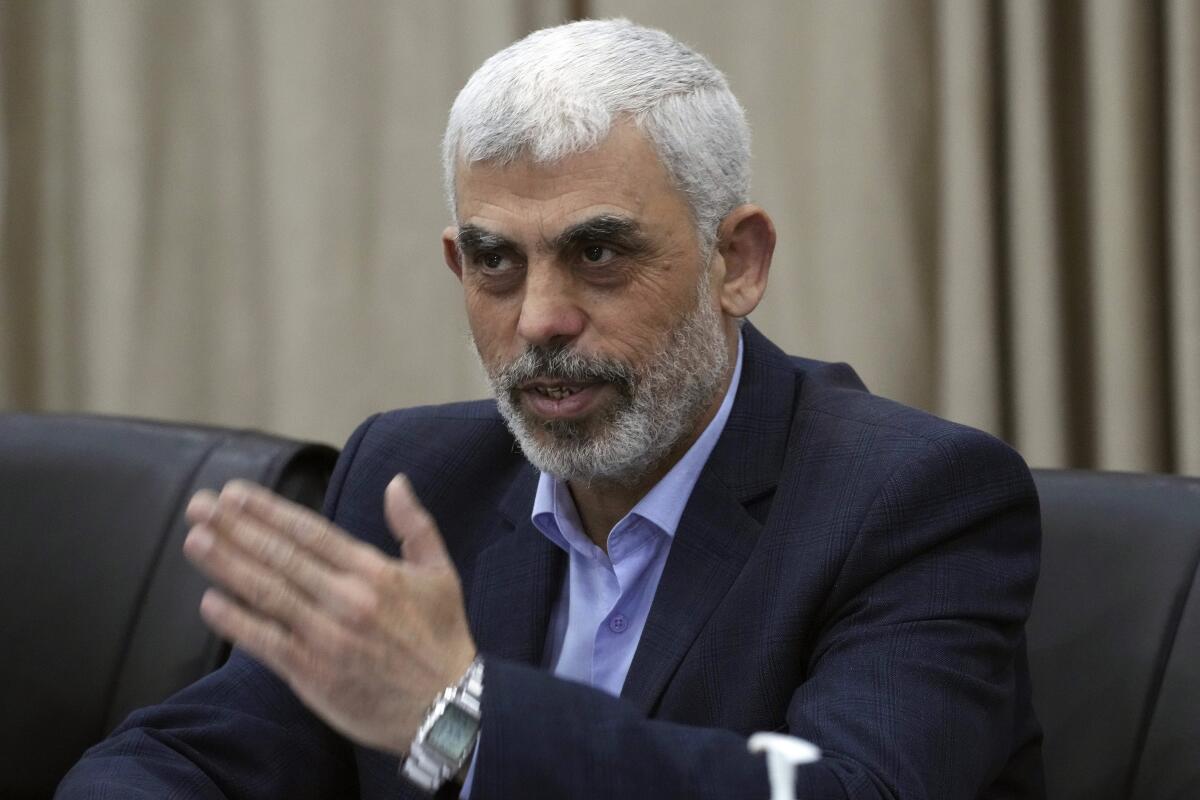Israel’s killing of Hamas’ leader is a harsh blow, but hardly fatal. What happens now?

- Share via
The killing by Israeli forces of Hamas leader Yahya Sinwar leaves the Palestinian militant group wounded, but hardly a spent force, analysts say.
Even before Sinwar’s death in a surprise encounter with Israeli troops in southern Gaza, the organization had been severely degraded militarily by more than a year of all-out warfare with Israel. But all sides agree that Israel’s stated wartime goal of destroying Hamas has gone unmet.
The leadership vacuum left by Sinwar’s killing will likely be temporary, longtime observers say, but it raises a host of questions about how Hamas will carry forward its battle with Israel.
Here is a look at what could come next for the group.
How heavy a blow?
In confirming Sinwar’s death — a full day after it was announced by Israel — Hamas said Friday it mourned the loss of a “great leader.” But it voiced defiance, vowing not to return the hostages seized on Oct. 7 of last year to Israel until there is a cease-fire in the Gaza Strip and a withdrawal of Israeli troops.
Israel has depicted Sinwar’s killing as a major victory. But some analysts said it could cement the group’s legitimacy in the eyes of followers, causing it to be perceived as even more central to the Palestinian national struggle.
“Yes, they’re weaker, but they’re never going away,” said Charles Lister of the Washington-based Middle East Institute, speaking in an online panel.
‘Decapitation’ doesn’t last
The Islamist militant group came into being in the late 1980s with the aim of destroying Israel. In the intervening years, its ranks have repeatedly been thinned by Israeli assassinations of its top leaders, dating back to its earliest days.
Israel even has a grim term for it: “mowing the grass.”
The internal disarray as a result of Sinwar’s death is perhaps more acute than that after past such killings, because it follows so closely on the heels of other leadership losses for the group.
Ismail Haniyeh, Hamas’ political chief, was killed in a suspected Israeli attack in the Iranian capital at the end of July. Mohammed Deif, the group’s then-military leader, died in an Israeli airstrike in Gaza earlier that month. And Hamas said Friday an important battalion commander, Mohammed Hamdan, had also been killed in the same confrontation that killed Sinwar.
Some analysts, though, suggested that killings of senior militant leaders often yield little long-term benefit.
“Over time, as Israel tries to decapitate these [militant] organizations, they tend to become more radical rather than more moderate,” said Andreas Krieg, a Middle East scholar at King’s College London.
Succession questions
Sinwar was believed to have told associates he did not expect to survive the war. But it wasn’t clear whether he left instructions on who to replace him.
Within Gaza, one obvious candidate is his younger brother, Mohammed Sinwar, who recently became the group’s military commander. The brothers spent time together in the course of the war, Israel says, but the younger Sinwar’s whereabouts and status are unknown.
On the political side, another figure is Khaled Meshaal, a Qatar-based founding member of the group. He chaired Hamas’ political bureau for nearly 20 years, until he was replaced by Haniyeh in 2017.
Another figure of note is Khalil al-Hayya, a lead figure in negotiations with Israel mediated by Qatar. He delivered Friday’s address confirming Sinwar’s death, which was a combined eulogy and rallying cry. In it, he hailed the slain leader’s “martyrdom,” saying it would “only increase the strength and resolve” of Hamas.
“The central hub has disappeared, and I don’t think it can be replicated,” Krieg said. But individual Hamas cells in Gaza, who already had a degree of autonomy, would be able to continue operating, he said.
Propaganda boost
Many regional observers were surprised by Israel’s release of dramatic drone video showing the last moments of Sinwar’s life as he battled Israeli troops who encountered him and a pair of fellow fighters. It’s already being mobilized to build his folk-hero legacy.
In a widely viewed clip, Sinwar is shown seated alone inside a shattered building, one arm maimed and motionless, using his good arm to hurl a stick or pole at the Israeli drone tracking him.
“This is propaganda gold for Hamas and Sinwar’s supporters,” analyst Rym Momtaz of Carnegie Europe wrote on the social media platform X.
The slain leader’s backers, she wrote, “will see in it the embodiment of Palestinian resistance, devastated and still defiantly fighting, not cowering in a tunnel.”
The Iran connection
Hamas is one of the Iran-sponsored proxy groups and state actors dubbed the “axis of resistance.” However, its ties to Tehran, assiduously tended to by Sinwar, are looser than those of the Shiite-dominated Lebanese group Hezbollah.
Iranian President Masoud Pezeshkian condemned Sinwar’s killing, and Hezbollah and Yemen’s Houthi rebels — fellow proxy groups — both expressed solidarity and condolences.
Even so, some analysts have described Hamas’ relationship with Iran as a marriage of convenience, and Sinwar’s disappearance from the scene might result in a less Iran-friendly senior figure coming to the fore.
“It’s an open secret that Khaled Meshaal has long been opposed to the idea Hamas throws all its eggs in the Iranian basket,” said analyst Lister.
More to Read
Sign up for Essential California
The most important California stories and recommendations in your inbox every morning.
You may occasionally receive promotional content from the Los Angeles Times.










